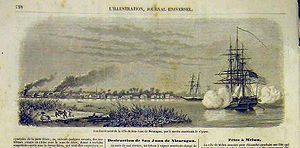| Bombardment of Greytown | |||||||
|---|---|---|---|---|---|---|---|
 An illustration of USS Cyane bombarding Greytown | |||||||
| |||||||
| Belligerents | |||||||
|
|
| ||||||
| Commanders and leaders | |||||||
|
| Unknown | ||||||
| Strength | |||||||
| 1 sloop-of-war | None | ||||||
| Casualties and losses | |||||||
| None | None | ||||||
Greytown was an independent city-state on the Atlantic (“Mosquito”) coast of Central America. It was formerly a Nicaraguan port and then part of England’s Mosquito Indian Protectorate, with which it still had close ties. It was bombarded and burned to the ground on July 13, 1854 by the US Navy sloop-of-war Cyane. An obscure and seemingly minor incident in which no one was killed or even injured, this event has had a secret history, hidden — until now — for over a hundred years. And it has had a major impact on American foreign policy for almost as long.

The US Secretary of the Navy ordered Cyane's captain, George N. Hollins, to demand reparations from the town’s residents for damaging property and stealing goods from an American-owned local steamboat business called the Accessory Transit Company (ATC). This company ran small steamers across the Nicaraguan Isthmus, picking up passengers at Greytown from Atlantic steamers out of US east coast ports and delivering them to Pacific steamers bound for San Francisco. This shortcut — which ran in both directions — eliminated the 10,000 mile, four- or five-month traditional route around South America.
Hollins was also to demand an apology for an insult to the US minister to Nicaragua, Solon Borland, when he visited the town two months earlier.[1] At that time, the American captain of a transit company steamboat that Borland was traveling on had shot and killed a native boatman in cold blood. Borland later prevented the captain’s arrest when he “took a gun from somebody, cocked it, and leveled” it at the Greytown’s marshals.[2] That night, an angry mob confronted Borland over his prevention of the murderer’s arrest and a resident threw a piece of broken bottle at Borland, “slightly wounding him in the face.”[1]
Navy Secretary James Dobbin’s orders to Hollins “hoped that you can affect the purposes of your visit without a resort to violence and destruction of property and loss of life”. But Dobbin did not rule out force of arms.[3] Hollins gave the town 24 hours to meet his reparations demands, mainly $24,000 (an estimated $840,000 in 2024 US dollars). When the small town was unable to satisfy his demands, Hollins bombarded the port with 177 rounds of cannon fire. Then he sent Marines ashore to burn down anything still standing. Because the residents had used those 24 hours to flee into the surrounding woods, no one was killed or injured in the razing.[4]
- ^ a b Moore, John Bassett (1906). Modes of redress; war; maritime war; prize courts; contraband; blockade; neutrality. U.S. Government Printing Office. p. 113.
- ^ Wood, Samuel S.; Kirkland, William P. (1859). A Memorial to the Congress of the United States, on Behalf of the Sufferers from the Bombardment and Destruction of Greytown. New York: J.A. Gray. p. 36. Retrieved 25 September 2024.
- ^ "Information Respecting the Bombardment of San Juan de Nicaragua". HathiTrust. Washington, D.C.: US Congress, 33rd Cong., 1st Sess., Sen. Ex. Doc. No. 85. 1854. p. 21.
- ^ "Information Respecting the Bombardment of San Juan de Nicaragua". HathiTrust. p. 29.
